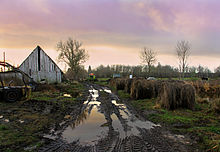Agriculture in Estonia
This article has multiple issues. Please help improve it or discuss these issues on the talk page. (Learn how and when to remove these template messages)
|

Like the rest of the
History

In 1991 roughly 12 percent of the
Reform of Estonia's agricultural system began in December 1989 with adoption of the Law on Private Farming (Estonian: Eesti NSV taluseadus).[1] The law allowed individuals to take up to fifty hectares of land for private planting and for growing crops.[1] The land was heritable but could not be bought or sold.[1] The goal of the reform was to stimulate production and return the spirit of private farming to a countryside worn down by decades of central planning.[1] Six months after implementation, nearly 2,000 farms were set up, with several thousand waiting for approval.[1] A year later, more than 3,500 private farms were operating.[1] Starting in October 1991, farmers were allowed to own their land.[1] This boosted the number of farms to 7,200 by early 1992.[1] As of the first half of 1993, a total of 8,781 farms had been created, covering approximately 225,000 hectares, or a quarter of Estonia's arable land.[1]
In May 1993, the
With the introduction of private agriculture, many collective farms began to disintegrate.
Production
Estonia produced in 2018:
- 450 thousand tons of wheat;
- 347 thousand tons of barley;
- 113 thousand tons of rapeseed;
- 88 thousand tons of potato;
- 78 thousand tons of oat;
- 53 thousand tons of pea;
- 29 thousand tons of rye;
In addition to smaller productions of other agricultural products. [3]
Forestry
Estonia has 1.8 million hectares of forest with approximately 274 million cubic meters of
Fishing

The fishing industry, once entirely under Soviet control, also has the potential to contribute to the country's economy.[1] With 230 ships, including ninety oceangoing vessels, this profitable industry operated widely in international waters.[1] A large share of Estonia's food-industry exports consists of fish and fish products.[1] In 1992 about 131,000 tons of live fish were caught.[1]
References
- ^ OCLC 34245562.)
 This article incorporates text from this source, which is in the public domain.
This article incorporates text from this source, which is in the public domain.{{cite encyclopedia}}: CS1 maint: postscript (link - ^ "Agriculture | Statistikaamet". www.stat.ee. Retrieved 2023-07-12.
- ^ Estonia production in 2018, by FAO
